Summary |
要約 |
>Top 0. Forces driving change:
- An understanding of the forces driving change is crucial to comprehending
the opportunities and the risks that change creates.
- This book is about the process of design and how it affects
the structure of industry. Design is the process of inventing
objects - our "things" - that perform specific functions.
("artifacts")
- Some artifacts are intangible. Rules , customs, systems of
law, and property rights are artifacts.
- Artifacts evolve. This is one of the most important characteristics
of "the very nature of the things."
|
0. 変化を生み出す力:
- 変化を生み出す力を理解することは、変化が作り出すチャンスとリスクを認識する鍵となる。
- 本書は、設計プロセスとそれが産業構造にいかに影響を与えるか述べている。設計とは、特定の機能を発揮するオブジェクト、即ち、モノを創造するプロセスである。
(人工物)
- 一部の人工物は無形である。ルール、慣習、法体系、知的所有権は人工物である。
- 人工物は進化する。これはモノの本質の中でも最重要の特徴の一つである。
|
>Top 1. Artifacts, Designs, and Structure of Industries:
- Computer:
Emerging on the scene in 1944, computer, their programs, and their
patterns of use - all artifacts - have developed in astonishing
ways.
- Most of us are not especially intrigued by their raw speed or
low cost. It is the many things computers do, and the many different
ways they can be configured, that makes them interesting and useful.
- Complexity and Modularity:
If an artifact can be divided into separate parts, and the parts
worked on by different people, the "one person" limitation
on complexity disappears. Two interesting points arise as we move
from simple to complex:
- (1) the point at which an artifact can no longer be made by
a single person. (division of labor)
- (2) the point at which an artifact can no longer be comprehended
by a single person. (division of knowledge and effort) Coordinating
mechanisms are needed.
- Modular Designs of Computers:
The first "truly modular" computer design was IBM's System/360,
a broad, compatible family of computer introduced in 1964. The graph
is the capital market values of different sectors of the computer
industry (1950-96) in 1996 inflation-adjusted dollar. IBM dominated
this industry for 40 years (the blue mountain range). Since the
late 1980s, Microsoft and Intel have been the largest firms in their
subindustries.
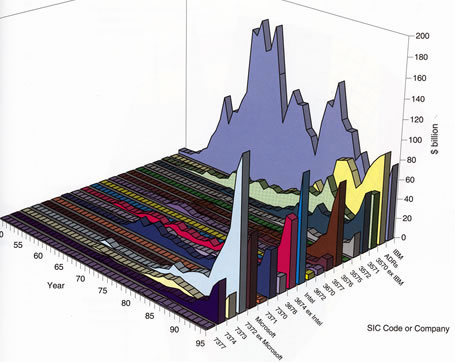
- The Changing Structure of the industry:
As IBM's value was dropping, whole new subindustries were emerging.
We defined the start date of a subindustry as the first year in
which Compustat reported six or more firms in a given 4-digit SIC(Standard
Industrial Classification) category.
- In the 1980s and early 1990s, economic power ceased to depend
on "extensive control" of all elements of a computer's
design, and instead came to depend on "intensive control"
of critical modules.
|
1.人工物、デザイン、産業構造:
- コンピュータ:
1944年に登場したコンピュータとそのプログラム、利用法 (いずれも人工物)は驚異的に進化した。
- 我々は、速度や低コストに特に興味をそそるのではない。コンピュータを使って多くのことを多くの異なったやり方でできるということが、おもしろいのであり有益なのだ。
- 複雑性とモジュール性:
もし人工物を異なる部分に分割でき、その部分毎に異なる人が作業できるならば、複雑性に関する一人の人間という限界はなくなる。 単純なものから複雑なものへ進むにつれて、興味深い時点がでてくる。
- (1) 一人の人間では一つの人工物を作れなくなるとき (労働の分割)
- (2)一人の人間では一つの人工物を理解できなくなるとき (知識と労力の分割) 調整メカニズムが必要となる。
- コンピュータのモジュール設計:
初のモジュール型コンピュータの設計は1964年に登場した。広範な互換性のあるコンピュータ・ファミリーであるIBMのSystem/360である。左図は1996年のインフラ調整後ドル換算で、1950-96年のコンピュータ産業の各セクタの市場価値のグラフである。IBMは40年間もこの産業を支配してきた。
(青色の山) 1980年代後半以降、マイクロソフトとインテルが下位産業では最大企業となっている。
- 変化するコンピュータ産業構造:
IBMの市場価値が下落すると、全く新たな下位産業が出現してきた。ここでCompustatの4桁産業分類に6社以上登録された時点で、その下位産業の開始年と定義した。
- 1980年代と90年代初めには、経済的な力は、コンピュータ設計におけるすべての要素を「広範囲に統制」することではなくなり、主要なモジュールに特化した「集中的に統制」に依存するようになった。
|
>Top 2. Microstructure of Designs:
- Artifacts: Their Structure and Functions
- It is in these microscopic elements of structure that we find
the critical mappings that link changes in designs to changes
in organizations, markets, and industries.
- We need to add the related concepts of design, design
parameters, and design tasks.
- An artifact's design is an abstract description that
encompasses both its structure and its functions. The difference
between a design description and other descriptions is that the
design description needs to be both precise and complete. A thin
that is imagined by a designer cannot become a thing that is real
until all its structural elements have been chosen.
- Structure: Design Parameters
- Designs may be recorded and communicated in various ways:
through natural language, scientific language, pictures, blueprints,
prototypes, and compute files (CAD).
- Notation: The "Space" of Designs
- The set of design parameters needed to describe completely
a particular artifact is then a vector X: X = <x1, x2,
... , xn>. The categories
in the set or list in turn make up the dimensions of an imaginary
"space" - the space of designs.
- Hierarchical Design Parameters
- Hierarchical parameters are the way in which designers delimit
and thereby bound the space of designs they plan to search.
Without these "on/off" switches, the space of possible
designs is impossibly immense, amorphous, and unstructured.
- Functions: Primary, Subsidiary, and Supplemental
- Artifacts can also have subsidiary and supplemental functions.
Subsidiary functions elaborate and extend the primary function;
they serve to differentiate artifacts within a given class,
hence are very important in competitive settings.
- Supplemental functions offer alternatives, or run in parallel
to the primary function.
- In general, an artifact's value or worth in society is determined
by its function, and not by its structure.
- Design, Production, and Use of an Artifact
- The domains of design and production are not so easily distinguished.
- Once what is to be made and how to make it are known, exactly
and completely, the design process is over, What remains then
is pure production.
- If there are deviations from the recipe, then those are part
of the search for an unknown solution, hence part of a design
process, not part of the production process.
- When design and production are carried out at the same time
and in the same place, they will engender conflicting objectives.
Searching for something better slows down production, and uses
resources. The search for new designs also introduces uncertainty
into any process. In contract, the output of a pure production
process is a certainty.
- When tangible goods are being produced the design process must
stop at a point that leaves enough time for the existing production
algorithm to be executed. (freeze point)
- Mass production relies on automatic processes that execute precise
algorithms at high speeds.
- Role of Designers
- The designer selects the design parameters of an artifact so
that the artifact "works," is makable, and, if possible,
pleases the user as well.
- A designer must also be able to predict changes in functionality
that will arise from specific changes in structure.
- A designer must be able to weigh potential changes in structure
and function, adjust for uncertainty, and decide whether a new
design is worth trying or not.
- Our theory of design evolution thus rests on the idea that human
beings are capable of visualizing new artifacts in an imaginative
domain, and then acting purposefully to bring those artifacts
into existence in the real world: Designers see and seek value
in new designs.
|
2. 設計の微細構造:
- 人工物:その構造と機能:
- 組織、市場、産業の変化を結びつけ得る決定的なマッピングは、構造の微視的な要素の中にある。
- ここで関連する概念として、設計、設計パラメート、設計タスクを加える必要がある。
- 人工物の設計とは、その構造と機能の両方を包含する抽象的記述。設計の記述のその他の記述との違いは、前者は正確で完全であることが求められる。設計者がイメージするものは、そのすべての構造的要素が選択されて、初めて実在となる。
- 構造:設計パラメータ
- 設計は種々の方法で記録され伝達される。自然言語、化学的言語、絵、青写真、プロトタイプ、コンピュータファイル (CAD)など。
- 表記:設計空間
- ある人工物を完全に記述するために必要な設計パラメータの集合は、ベクトル X: X = <x1, x2,
... , xn> である。これによって、この集合またはリストは、仮想的な空間の次元を構成する。これが設計空間である。
- 階層的な設計パラメータ:
- 階層的なパラメータは、設計者が探求する設計空間の範囲を制限し境界を定める方法である。 こうしたオンオフのスイッチがないと、設計空間は、限りなく膨大、無定形、無構造なものとなる。
- 機能:主要機能、副次機能、追加機能
- 人工物は、副次機能と追加機能をもつ。副次機能は主要機能を精巧にし拡張する。こうした機能は、その種類の中での人工物を差別化するのに役立ち、競合する環境では非常に重要とある。
- 追加機能とは、代案を提供し、あるいは主要機能に併行するものである。
- 一般的に、社会における人工物の価値・真価はその構造ではなく機能によって決まる。
- 人工物の設計、生産、利用
- 設計と生産の領域は、簡単にはくべつできない。
- 何を作るべきか、どのように作るべきかが、一旦、正確かつ完全にわかれば、設計プロセスは終了する。後は、純粋な生産が残るだけである。
- もし、レシピからの逸脱があれば、それは道の解決方法を探求することとなり、設計プロ説の一部であって、生産プロセスの一部ではない。
- 設計と生産が、同時に同一場所で行われると、目的に対立が生じる。改善を探求することは、生産スピードを落とし資源を消費する。また新たな設計を探求すると、どのプロセスにも不確実性をもたらす。対照的に純粋な生産プロセスのアウトプットは確実なものである。
- 有形物を生産するときには、既存の生産アルゴリズムが実行されるまでの十分な時間は、設計プロセスは、一旦休止しなければならない
(凍結ポイント)
- 大量生産は、正確なアルゴリズムを高速で実行する自動化プロセスに依存している。
- 設計者の役割
- 設計者は、人工物の設計パラメータを選ぶことによって、人工物が機能し、製作可能であり、できればユーザを喜ばせるようにする。
- 設計者は構造面でのある変更によって生じる機能の変化を予測できなければならない。
- 設計者は、構造と機能の面で変更の可能性を斟酌し、不確実性に適応し、新たな設計を試す価値があるか否かを判断できなければならない。
- 我々の設計の進化理論によれば、人類は、想像的な領域において、新たな人工物を可視化し、意図的に行動して、現実世界にその人工物を実現することができる。即ち、設計者は新たな設計の中に価値を見つけて探求する。
|
- >Top
- Design Parameter Interdependency:
- It would be relatively easy to design an artifact if all its
design parameters were independent, and each contributed to the
artifact's functions in its own way. Unfortunately, design parameters
depend on one another, often in very complex and convoluted ways.
- Design parameter interdependency can be illustrated by a simple
but general example; "fit interdependency." This type
of interdependency arises in every realm of design that involves
tangible artifacts - in mugs, in computers, in pistons, and in
plugs.
- Seeing and Seeking Value in the "Space" of Designs:
- The designers' job is to find the islands in the sea of possible
designs - in other words, the designs that "work." Then,
within in and across all the islands, designers must seek the
highest peaks - the designs that work better than any others,
and generate the highest values.
- Working in a very complicated design space, with millions upon
millions of parameters, computer designers must "see"
the structural interdependencies and their functional consequences,
and "seek" those combinations that deliver the most
speed for the least cost.
-
Design Structure:
Design structure matrix (DSM): a map of a portion of the design structure of a mug.
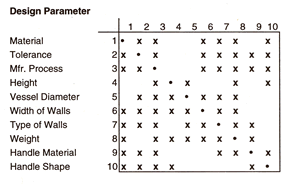
-
Hierarchical relationships and interdependencies
among design parameters can be formally mapped using a tool
called the design structure matrix (DSM). The mapping procedure was invented
by Donald Steward, and refined by Steven Eppinger.
- To construct a DSM, one assigns the individual parameters
of a design to the rows and columns of a square matrix. Then,
going down the list, if parameter a is an input to parameter b, one put
a mark (an X) in the column of a and the row of b.
- The matrix was constructed by asking, with respect to each
parameter: If this parameter were changed for any reason, what
other parameters might have to be changed too?
- However, like any map, a DSM is only as good as the knowledge
that goes into it. Unknown interdependencies can be fatal or merely
annoying, requiring extra work. Or they can be fortunate, revealing
new "peaks" of value. Hence, unknown interdependencies are one of the primary sources of uncertain in design processes.
|
- 設計パラメータの相互依存性
- もしすべての設計パラメータが独立しており、各々が独自に人工物の機能に貢献するならば、人工物を設計することは比較的容易であろう。不幸にして設計パラメータは、しばしば非常に複雑に絡み合った状態で相互に依存している。
- 設計パラメータの相互依存性は、単純だが一般的な「組合せの相互依存性」の例でうまく説明できる。このタイプの相互依存性は、マグ、コンピュータ、ピストン、プラグなど有形の人工物の含むすべての設計領域で発生する。
- 設計空間における価値の認識と追求:
- 設計者の仕事は、設計の可能性の海から島、即ち「機能する」設計を見つけ出すことにある。さらに、他のどの島よりもよく機能し、最高の価値を生み出す設計を探さなければならない。
- 非常に複雑な設計空間の中で、何百万ものパラメータを扱いながら、コンピュータ設計者は、構造上の相互依存性とそれらの機能面の結果を見つけ、最小コストで最大スピードをもたらす組合せを探求しなければならない。
- 設計構造:
<左図>設計構造行列 (DSM) -あるマグの設計構造の見取図の一部
- 設計パラメータ間の階層的な関係性と相互依存性は、設計構造行列 (DSM) と呼ばれるツールを用いて形式的にマップ化できる。マップ化の手順は、Dolanld
Stewardが発明し、Steven Eppingerが改良した。
- DSM を作るには、ある設計の個々のパラメータを正方行列の行と列に割り当てる。そして、リストを下に読んでいき、もしパラメータa がパラメータb の入力となっていれば、a列とb 行の交点に印 (X)をつける。
- この行列は、各々のパラメータについて、「もしこのパラメータが何らかの理由で変更されたら、他のどのパラメータが変更されなければならないのか?」と質問しながら作成されたものである。
- しかし、DSMも他のマップと同様、取り込まれている知識と同程度のものでしかない。未知の相互依存性が存在し、設計空間に突然出現することがある。未知の相互依存性は、致命的だったり、単に厄介だったり、余分な作業を要したりする。従って未知の相互依存性は、設計プロセスにおける主な不確実性の源泉の一つである。
|
- >Top
- Task of Design
- The design process begins and ends with a list of design parameters
that are also design tasks. At the beginning, the list is a
set o decisions that will be made, that is, tasks that will be performed. At the end of the process, the list tells of the
decisions that have been made, that is, task that were performed.
- Task Structure of a Design Process
- The task structure of a design process consists of
- a list of tasks, corresponding to the design parameters
to be selected;
- a list of all precedence relationships between tasks;
- an assignment of each task to one or more "doers"
of the task.
- A "precedence relationship" means that the output
of task A is an input to task B.
- In this mapping of actors to tasks, there is room for multiple
task assignments, and joint responsibility. It is even possible
to specify delayed, conditional task assignments (whoever selects
the material, X1, will select the manufacturing
process, X3). What is problematic, however,
is an unassigned task, for the design process will not be complete,
until all necessary tasks have been accomplished.
- Fractal Nature of Tasks:
- A very deep problem arises when specifying the "basic
unit" of a task. Ultimately, tasks are defined by
the instructions given to those who will do them. For the same
task, different instructions are given to a human being, an
animal, or a machine. We have an innate ability to assembly
very basic tasks into meaningful groups, and to receive of a
job in terms of larger task units, not smaller ones. Most dogs
and all machines need more detailed instructions perform this
task.
- Hence, human task structure have a fractal property - within
each large task lies a set of smaller tasks, and within each
of those there may lie a set of still smaller task.
- Human being do not seem to by stymied by this inherent ambiguity.
We "chunk" and "unchunk" tasks quite easily,
moving form one level of task definition to another, according
to what is most convenient for the job of the moment.
|
- 設計タスク
- 設計プロセスは、設計タスクでもある設計パラメータのリストに始まり、リストに終わる。最初の時点では、そのリストとは、なされるべき意思決定、即ち、実行されるであろうタスクの集合である。プロセスの最後では、そのリストは、実際に行われた意思決定、即ち、実行されたタスクを示している。
- 設計プロセスのタスク構造
- 設計プロセスのタスク構造は、以下のように構成される。
- 選択される設計パラメータに対応するタスクのリスト
- タスク間のすべての優先関係のリスト
- 1人以上のタスクの実行者への各タスクの割当
- 優先関係とは、タスクAの出力がタスクBの入力となることを意味する。
- タスクに対する動作主のこの表では、複数のタスクを割り当てたり、あるいは共同責任とする余地がある。後で条件に従ってタスクを割り当てる
(素材 X1 を選んだ人は製造プロセス X3 を選ぶ) こともできる。問題となるのは割り当てられていないタスクである。すべての必要なタスクが達成されるまでは、その設計プロセスは完全とはならない。
- タスクのフラクタル的性質:
- タスクの基本単位を特定するときある深い問題が登場する。結局、実行者に与えられっる指示によってタスクは定義される。同じタスクであっても、人間、動物、機械によって異なる指示が与えられる。我々には非常に基礎的なタスクを意味のあるグループにまとめて、大きなタスクの塊として仕事を認識する生来の能力がある。犬や機械にこのタスクを実行されるには、もっと詳細な指示が必要になる。
- 従って人間的なタスク構造はフラクタル的な性質をもつ。つまり各々の大きなタスクにより小さなタスクの集合が含まれ、それらの中に、さらに小さなタスクの集合が含まれる。
- 人間が減来の曖昧さによって妨害されることはないように見える。我々はタスクを容易にまとめたり、分解したりして、その時々の仕事に最も都合の良いように、あるレベルのタスクから別のレベルに移動したりする。
|
- >Top
- Deductive vs. Inductive Mapping of Design Structures and
Task Structures:
- The first is to look at an artifact, list its design parameters,
and categorize the hierarchical relationships and interdependencies.
- The second is to seek out the people involved in the design
process, and ask them "What parameters do you select?"
and "Whose decisions do you need to know in order to make
your decision?"
- The first is a deductive approach; the second is an inductive approach. The inductive approach can tap the specific, tacit
knowledge of designers about dependencies. The deductive approach,
in contrast, requires there to be a generally accepted body
of theory that describes what the artifact is and how it works.
Hence the inductive approach requires less in the way of codified,
formal knowledge about the artifact and its designs than the
deductive approach.
- Cycling through Design Parameters:
- In the design of a heat exchanger, the temperature (A) depends
on the heat flux (B), the (B) depends on the heat transfer coefficient
(C), and the (C) depends on the (A). This is a circuit. (an interdependency,
involving three parameters)
- This process of searching, problem solving, and cycling is one
of the most creative known. Through it, new parts of the design
space can be explored, and new "peaks" of value can
be discovered.
- Dominant Designs, Frozen Organizations, and Complexity
Catastrophes:
- As designers worked on the agenda of problems established by
the dominant design, the locus of competition between firms would
shift from product improvement to cost reduction. A "productivity
dilemma" would then emerge, as the search
for lower cost drove out, first, large innovations, and later,
all but the most minor innovations.
- Thus, as an enterprise becomes more efficient, it also "necessarily"
becomes more rigid and inflexible. Metaphorically, it gets trapped
in its own problem-solving trajectory, and then evolves toward
a "frozen state"
in which no substantive innovations are possible.
- This outcome can be understood as the end result of the development
of an interconnected task structure in which actions taken to
resolve dependencies are not recorded, but instead become part
of the tacit knowledge of an enterprise. In this setting, the
mechanisms for making decisions, sharing information, and resolving
conflicts will come to be embedded in unmapped organizational
routines. This in turn leads to a classic "complexity
catastrophe," in which as the number of tasks
and the number of unrecorded connections increase, only very small,
isolated changes can be made to the overall system.
- Modularity offers a way to avoid this complexity
catastrophe, and to preserve flexibility within a complex system.
The driving force behind a quest for modularity is always a desire
to achieve the right balance between fruitful uncertainty and
paralyzing complexity.
|
- 設計構造とタスク構造のマッピングにおける演繹法と帰納法:
- 第一の方法は、ある人工物をみてその設計パラメータをリスト化し、その階層的関係や相互依存性を分類する。
- 第二の方法は、設計プロセスに関わる人々を探して、彼らに「どのパラメータを選ぶか」「あなたの意思決定を行うのに、誰の決定を必要とするか」を尋ねる。
- 第一の方法は演繹的アプローチで、第二に方法は帰納的アプローチである。帰納的アプローチは、従属関係について設計者の暗黙知を引き出すことができる。対照的に、演繹的アプローチは人工物が何であり、どのように機能するかを記述する一般的に受け入れられる理論体系を必要とする。従って、帰納的アプローチでは、演繹的アプローチに比べて人工物やその設計に関する体系化された形式知は多くは必要としない。
- 設計パラメータ間の循環:
- 熱交換機の設計では、温度(A)は、熱流束(B)に依存し、(B)は、熱伝導係数(C)に依存し、(C)は(A)に依存する。これは回路である。
(3つのパラメータが関わる相互依存性)
- 探索と問題解決と循環のこのプロセスは、知られている最も創造的なプロセスの一つである。これらをと怖じて、設計空間の新たな部分が開拓され、新たな価値の「山頂」が発見される。
- 支配的設計、凍結組織、複雑性の破局:
- 設計者は、支配的な設計によって確立された工程に従って仕事をし、企業間競争の場が、製品改良からコスト削減に移るであろう。コスト削減の探索によって、当初は大きな革新が、やがては最も小さなものを除いてすべての革新が駆逐されると「生産性のジレンマ」が生じてくる。
- このように、ある企業がより効率的になるに従って、必然的により硬直的で、柔軟でないものになる。比喩的に言えば、自らの問題解決経路の落とし穴に陥ってしまい、もはや実質的な改革が不可能な「凍結状態」に向かって進んでいく。
- この結末は、相互関連タスク構造の開発がもたらす最終的な結果であると理解できる。そこでは総合依存性を解くための行動が記録されず、企業の暗黙知の一部となってしまう。この状況では、意思決定を行うメカニズムや情報共有、紛争解決は、マップ化されない組織的な日常業務の中に埋め込まれてしまう。さらに記録されないタスクの数や連結の数が増加すると、システム全体に対しほんのわずかの孤立した変化しか起こせないという古典的な「複雑性の破局」につながる。
- モジュール化は、この複雑性の破局を避け、複雑なシステム内での柔軟性を維持する方法を与える。モジュール化を追求する陰の立役者は、常に、実り多い不確実性と麻痺するような複雑性との間の適度なバランスを達成したいという願望である。
|
- >Top
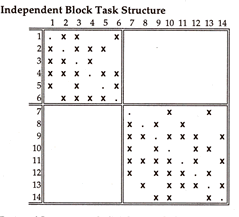 Taxonomy of design and task structures: Taxonomy of design and task structures: - 1) Independent Block Structure:
There are many connections within each block, but no connections
across the blocks. There is also no information common to both blocks:
actors in one are wholly ignorant of what those in the other might
be doing.
- 2) Strictly Hierarchical or Sequential
Structure:

- Tasks must be performed in a strict order. Moreover the only
input to a particular task is the the task immediately before
it. This structure is representative of the flow line processes
underlying modern mass production. (Henry ford's assembly line)
- 3) Hierarchical block Structure:
- The outputs of the first block are inputs to the second block,
but the reverse is not true. This is a very common patter in
design process. In modular structures, design rules cannot be
changed after the fact without drastically compromising the
process.
- 4) Hybrid Structure:

- Different types of structures may be combined to form may
hybrid types. The figure shows one common pattern; an interconnected
process provides inputs to a sequential process. May design-and-manufacturing
processes exhibit this pattern.
- However, when the relative magnitudes of the fabrication and
design costs are reversed, it is sensible to fabricate a very
large number of trial designs and then test them. Such inverted
processes are common in agricultural and pharmaceutical research.
|
- 設計とタスク構造の分類: (左図)
- 1) 独立ブロック構造:
- 各ブロック中には、多数の連結があるが、ブロックを超える連結は存在しない。2つのブロックに共通する情報もない。即ち一方の当事者は、他方が何をしているのか全くわからない。
- 2) 厳格な階層・順次型構造:
- タスクは、厳格な順序で実行されなければならない。またある特定のタスクに対する唯一の入力は、その直前のタスクである。この構造は、現代の大量生産を支える流れ作業ラインの典型である。
(ヘンリー・フォードの組み立てライン)
- 3) 階層的ブロック構造:
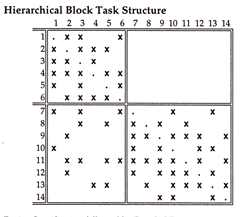
- 1番目のブロックの出力は、2番目のブロックの入力となるが、その逆はない。これは設計プロセスで、よくあるパターンである。モジュール型構造では、プロセスに関して劇的な歩み寄りがなければ、デザイン・ルールは変えられることはない。
- 4) ハイブリッド構造:
- 異なるタイプの構造が結合して、多数の複合タイプを形成する。この図は、ある一つの典型的なパターンを示している。即ち、相互関連プロセスが、連続プロセスの入力となるパターンであり、多くの設計~製造プロセスはこのパターンをとる。
- しかし製造と設計コストの相対的な規模が逆転すると、非常に多くの試作の設計を実際に製作し、試験することは理にかなってくる。このような逆転したプロセスは、農業や製薬の研究では一般的である。
|
>Top 3. What is Modularity?:
- Two subsidiary idea are subsumed in the general concept.
- The first is the idea of interdependence within and independence
across modules.
- A module is a unit whose structured elements are powerfully
conne4cted among themselves and relatively weakly connected
to elements in other units. Clearly there are degrees of
connection, thus there are gradations of modularity.
- The second idea is captured by three terms; abstraction, information hiding, and interface.
- A complex system can be managed by dividing it up into
smaller pieces and looking at each one separately. When
the complexity of one of the elements crosses a certain
threshold, that complexity can be isolated by defining a
separate abstraction that has a simple interface. The abstraction
hides the complexly of the element; the interface indicates
how the elements interacts with the larger system.
- Herbet simon's parable of two
watchmakers:
- There once were two watchmakers,
named Tempus and Hora, who manufactured very fine watches. The
watches consisted of about 1000 parts each. Tempus had so constructed
his that if he put it down - to answer the phone, say - it immediately
fell to pieces and had to be reassembled from the elements.
- The watched that Hora made were
no less complex than those of Tempus. But he had designed them
so that he could put together stable subassemblies of about
10 elements each. Hence when Hora had to put down a partly assemble
watch to answer the phone, he lost only a small part of his
work.
- If there is one chance in ten, that
either watchmaker will be interrupted while adding any one part
to an assembly - ten it will take Tempus on the average about
4000 times as long to make a watch as Hora.
|
3. モジュール化とは:
- 一般概念には2つの補助概念が付随している。
- 一つ目の概念は「モジュール内では相互依存し、モジュール間では独立している」というものである。
- モジュールは、その内部では構造的要素が強固に結びつき、他のユニットの要素とは比較的弱く結びついている一つの単位をいう。その結びつきの程度には明らかな差があり、またモジュール化には濃淡がある。
- 二つ目の概念は、3つの用語で捉えられる。
抽出、情報隠蔽、インターフェイスである。
- ある複雑なシステムは、より小さな部分に分割して、各々を別個のものとして見ることで管理できる。ある要素の複雑さが一定限界を超えるときは、単純なインターフェースをもつ別個の抽出を定義することで、その複雑性を隔離できる。つまり抽出によってその要素の複雑性が隠される。インターフェイスは、より大きなシステムに対して要素がどう作用するかを示す。
- 2人の時計職人(H.サイモンの寓話):
- 昔、テンプスとホラという2人の時計職人がいて非常に良い時計を作っていた。各々の時計は約千個の部品からできていた。テンプスは、電話に出たりして、彼が手を離すとたちまち部品に分解してしまい、もう一度、要素から組み立て直さなければならないような作り方をしていた。
- ホラの作る時計は、テンプスのものほど複雑ではなかった。しかし彼は、10個の要素毎に安定した半製品になるように設計した。こうして、ホラが途中まで組み立てた時計を置いて電話にでたとしても、彼が失う作業はほんの少しだけだった。
- 一つの組立に対して一つの部品をつけようとするときに10回に1回中断されるとしたら、一つの時計を作るのに、テンプスはホラに比べて約4000倍もの時間がかかってしまう。
|
- >Top
- Design Modularization:
- In order to modularize a design and its corresponding task
structure, the architects must have as their goal the creation
of a set of independent blocks at the core of the design process.
They must then set about systematically to sever all dependencies
known to exist across the protomodules.
- Information Hiding:
- For a modularization to work in practice, the architects must
partition the design parameters into tow categories; visible information
and hidden information.
- If the details of a particular block of code were consciously
"hidden" from other blocks, changes to the clock could
be made without changing the rest of the system.
- Interface is a preestablished way to resolve potential conflicts
between interacting parts of a design. It is like a treaty between
two or more subelements. To minimize conflict, the terms of these
treaties. Interfaces are visible information.
-
Design hierarchy:
A Design hierarchy with four hidden modules and three levels of
visibility.
 There
are three levels of visibility/invisibility. The global design
rules are directly visible to modules B and C and indirectly visible
to module A and D. This means that designers of hidden module
B and C must know the global design rules as well as their local
interface specifications, while designers of module A and D need
only know their local interface. There
are three levels of visibility/invisibility. The global design
rules are directly visible to modules B and C and indirectly visible
to module A and D. This means that designers of hidden module
B and C must know the global design rules as well as their local
interface specifications, while designers of module A and D need
only know their local interface.
- Changing visible information requires changing parts of all
designs that "see" that information either directly
or indirectly. Therefore, changes at the top of the diagram
will have far-reaching consequences, and are bound to be difficult
and expensive. Conversely, changes at the bottom of the diagram
are limited in scope, hence cheaper to implement, at least in
comparison to visible changes. Hidden design choices are reversible.
- Reality of Design Rules:
It is important to stress that he rules used to modularize a design
are never arbitrary and they do no arise costlessly. A modularization
requires the reorganization of fundamental design parameters based
on knowledge gleaned from previous designs.
- Setting design rules also adds a new group of tasks to project,
providing an overhead burden.
|
- 設計のモジュール化:
- ある設計とそれに対応するタスク構造をモジュール化するためには、アーキテクトは、目標として設計プロセスのコア部分に独立したブロックの集合を作らなければならない。
- 情報を隠すこと:
- モジュール化が実際に機能するためには、アーキテクトは設計パラメータを2つに区分しなければならない。即ち、可視情報と隠匿情報とである。
- もしコードの特定ブロックの詳細部分が他のぶろっくから意図的に隠されている場合には、システムの他の部分を変更することなく、そのブロックを変更できる。
- インターフェイスは、ある設計の中で相互作用する部分間で起こりう得る対立を解消するために事前に決められた方法である。それは、2つ以上の下位要素間で結ばれる条約のようである。インターフェイスは可視情報である。
- 設計階層:
設計階層には4つの不可視モジュールと3層の可視レベルがある。(左図)
3層の可視・不可視レベルがある。グローバルデザインルールはモジュールBとCに対しては直接、またAとDに対しては間接的に可視である。つまり、モジュールBとCの設計者はそれらのローカルインターフェイススペックと同様にグローバルデザインルールを知らなければならない。しかしモジュールAとBの設計者はそれらのローカルインターフェイスだけを知ればよいのである。
- 可視情報を変更すると、直接または間接に見ている設計の部分を変更しなければならない。階層図の最上層の変更は広範囲に影響を及ぼし、その変更は困難かつ高価となる。反対に、階層図の底辺での変更は、可視の部分の変更に比べ、少なくとも範囲が限定され、実行面でも安価ですむ。また隠された設計の選択はやり直しがきく。
- デザインルールの現実:
ある設計をモジュール化するルールは決して恣意的ではなく、またコストがかからない訳でもないことは留意すべきである。モジュール化は、それ以前の設計から収集した知識に基づき、基礎的な設計パラメータの再編成を必要とする。
- デザインルールの設定も、プロジェクトに新たなタスクのグループを追加することになり、オーバーヘッドを発生させる。
|
>Top 4. Economic System
surrounding Artifacts and Designs:
- Our theory of design evolution holds that a "force of value"
originates in the minds of designers, and is then magnified by product
markets. In advanced market economies, this "force" is
further intensified by the workings of the capital markets.
- In addition to valuation technologies, designers
have access to contracting and guidance
technologies. Contracting technologies make it possible
to form and sustain collective enterprises efficiently and al
low cost. Guidance technologies make it possible to coordinate
large and small groups of people and "point" them
in particular directions.
- Valuation Technologies:
- Value is a measure of an artifact's worth in a particular
social context. The formal definition of value begins with a
comparison of alternatives.
- To complicate matters, however, the nature of value will change
depending on the economic system in which users and designers
operate.
- In particular we want to distinguish between the following
different types of value:
- ex ante predicted value and ex post realized value,
- personal value and market value,
- value measured in product markets and value measure in
the capital markets.
- Ex ante predicted value vs. ex post realized value:
- One possibility is the process of blind selection.
Variations in artifacts might arise through accidental modifications,
followed by some form of rewards, and the retention of favorable
innovations. (evolution by natural selection)
- Human designers have the capacity to imagine, to analyze,
and to act with intent. It is the expectation of gain,
not blind chance, that draws human effort into design processes.
- The designers can select not only the designs of artifacts
but also the designs of the processes that generate the design
of artifacts. This property is called "recursiveness"
and it will play a very important role in our theory of design
evolution.
- >Top Personal value vs. market value:
- In a society without markets, a designer might "see"
a better way to make an artifact, and predict a gain from making
it along the new lines.
- Using intuitive reckoning alone, with a fuzzy concept of advantage,
the designer could still "see value."
- Markets offer two important benefits. First, they centralize
and simplify trade, thereby reducing the costs of exchange,
and increasing potential rewards to the designers of new artifacts.
Second, they give designers a valuation technology, that is,
an easier way to calculate the values that others will place
on a new design for an artifact.
- Role of Capital Markets:
- Advanced capital markets thus provide incentives to entrepreneurs
to form collective enterprises for the purpose of designing and
producing complex artifacts. By tapping into the capital markets,
entrepreneurs can stand as intermediaries between the preferences
of designers.
- The valuation technologies of the capital markets can take complex
and risky payments occurring at different points in time, apply
appropriate prices, and come up with a single number called the
"present value." (NPV = V- I)
- Valuation technologies have developed greatly in the last fifty
years, fueling in turn an explosion in capital markets and financial
institutions. A new type of financial firm (the venture capital)
appeared whose purpose was to invest in new firms making new artifacts.
- Contracting Technologies:
- Voluntary contracts are the basis of most economic undertakings.
They do not have to be formal, explicit, or legally enforceable
to be effective; many are informal and implicit, and either "self-enforcing,"
or enforced by personal standards of honor or deeply-ingrained
cultural norms.
- The main advantages are that with standardized contracts, many
of the organization's "rule of operation" will be familiar
to most participants, will not have to be invented from scratch,
and will not here to be renegotiated each day.
- A contract structure secures the resources for and captures
the value of a task structure, but its is not itself a task structure.
- The purpose of a contract structure is to bring those resources
together to allow the internal organization to implement the task
structure as efficiently as possible.
- A great deal of knowledge is involved in the design of contract
structures. This technology encompasses knowledge of human behavior,
economics, accounting, and the law.
- One difficulty with innovation in the contractual domain is
that contract designs are not considered "property"
in our society. Therefore, a new form of contract can be imitated
almost as soon as it is introduced.
- Task structure and contract structure interdependencies:
- Many contract structure can be effectively used to "package"
any given task structure. One potential contract structure is
for the fab to be owned by a corporation, which might issue shares
to finance the construction of the facility. Another is to finance
its construction by issuing shares to its customers.
- The combination of "fabless" semiconductor firms
and specialized foundries is a relatively new contract structure
for firms in the semiconductor industry.
|
4. 人工物と設計をとりまく経済システム:
- 我々の設計進化理論では、「価値の推進力」が設計者が頭で考え、それは製品市場で拡大される。先進的な市場経済では、この推進力は資本市場の仕組みによってさらに強化される。
- 設計者は、評価技術に加えて、契約技術と誘導技術を使用できる。契約技術によって企業の集団を効果的かる低コストで形成し維持することができる。指導技術は人々の大小のグループを調整し、一定方向に「指し示す」ことができる。
- 評価技術:
- 価値は、特定の社会的な状況における人工物の価値の尺度である。価値に正式な定義は、代替え物との比較から始まる。
- しかし問題を複雑にするのは、価値の本質がユーザと設計者が作用する経済システムに依存するからである。
- 特に、以下の異なるタイプの価値を区別しておきたい。
- 事前の予測価値と事後の実現価値
- 個人的価値と市場価値
- 製品市場で測定される価値と資本市場で測定される価値
- 事前の予測価値と事後の実現価値:
- 一つの可能性は、目隠しの選択である。人工物の変化は、偶然の変更を通じてたまたま発生し、その後何らかの報酬が続き、有望な変革が保持される。(自然淘汰による進化)
- 人間である設計者は、想像し、分析し、意図して行動する能力がある。設計プロセスへの人間の努力を引き出すのは、目隠しのチャンスではなく利得への期待感である。
- 設計者は、人工物の設計のみなrず、設計を生み出すプロセスをも設計できる。この特性は、再帰性と言われ、我々の設計理論の中で重要な役割を演じる。
- 個人価値と市場価値:
- 市場のない社会では、設計者は、人工物を作る際により良い方法を見いだし、新たな道に沿うことで一定の利得を期待するだろう。
- 直感的な計算だけを使って、優位性の曖昧であっても、設計者は価値を見いだすことができる。
- 市場は、2つの大きな便益をもたらす。第一に、市場は取引を集中化し単純化する。交換費用を軽減し、新たな人工物について設計者にもたらす潜在的な報酬を増加させる。第二には、市場は設計者に価値技術を提供する。即ち人工物の新設計に対して、他人が与える価値を容易に計算する方法を提供する。
- 資本市場の役割:
- 先進的な資本市場は、複雑な人工物を設計製造する目的で企業集団を形成する起業家にインセンティブを与える。起業家は、資本市場に資金提供することで、設計者を選別する仲介者としての立場となり得る。
- 資本市場の評価技術によって、様々な時点での複雑かつリスキーな資金提供を行い、適切な価格設定をして、現在価値と呼ばれる単一の数字を呈示する。
- 評価技術は、過去50年で格段に進歩し、資本市場と金融制度の爆発的発展を促した。新しいタイプの金融機関として新たな人工物を作る新規企業への投資を目的とするベンチャーキャピタルが登場した。
- 契約技術:
- 自発的な契約は、ほとんどの経済行為の基礎である。それらが実効性をもつには、公式、明示的、あるいは法的執行の可能なものである必要はない。多くの契約は、非公式で、暗黙、自己執行力であるか、または個人の名誉や深く根ざした文化的規範によって強制される。
- 標準契約の主な優位点は、組織内の多くの運営ルールがほとんどの参加者にとって周知のものであり、最初から作り上げたり、毎日再交渉しなくてもよいことである。
- 契約構造は、タスク構造に資源を確保し、その価値を捉えることを保証するが、契約構造自体はタスク構造ではない。
- 契約構造の目的は、これらの資源を集中させて、内部組織をしてできる限り効率的にそのタスク構造に実行させるようにすることにある。
- 契約構造の設計に当たっては、膨大な知識を必要とする。契約構造の技術には、人間行動、経済、会計、法律の知識が含まれる。
- 契約分野で革新が困難な一つの理由は、我々の社会では、契約設計が「所有権」と見なされていないことである。それゆえ新たな契約形態は、導入されるとすぐに模倣されてしまう。
- タスク構造と契約構造の相互依存:
- 多くの契約構造が、与えられたタスク構造の「パッケージ化」に効果的に用いられている。一つのあり得る契約構造は、工場を所有する法人を設立し、その株式を発行によって建設資金をまかなう方法である。もう一つは、顧客に対し株式を発行することでその建設資金をまかなう方法である。
- ファブレスの半導体企業と特定のファウンドリー企業との組み合わせは、半導体産業の企業としては比較的新しい契約構造である。
|
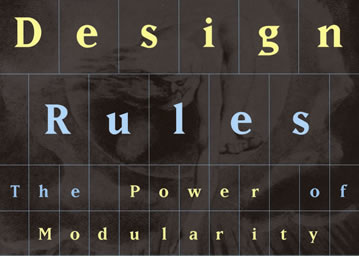



 Taxonomy of design and task structures:
Taxonomy of design and task structures: 


 There
are three levels of visibility/invisibility. The global design
rules are directly visible to modules B and C and indirectly visible
to module A and D. This means that designers of hidden module
B and C must know the global design rules as well as their local
interface specifications, while designers of module A and D need
only know their local interface.
There
are three levels of visibility/invisibility. The global design
rules are directly visible to modules B and C and indirectly visible
to module A and D. This means that designers of hidden module
B and C must know the global design rules as well as their local
interface specifications, while designers of module A and D need
only know their local interface.